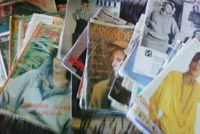First-Ever Fashion Magazine Was Made for Men by Men
History of fashion magazines goes hundreds of years back. The first magazine was created by a man for men. The first "female" magazine appeared 317 years ago on June 27, 1693 in London. A forefather of this publication was Frenchman Jean Donno de Vise.

In 1672, a magazine of literary-critical content "Gallant Mercury" was started in French Lyon. Even the king enjoyed. At the time, Jean Donno de Vise was a successful publisher who was not hiding his own literary talent.
Due to the irregularity of "Mercury" issues, Louis XIV addressed the publisher and demanded that the magazine is published monthly, in order to enlighten the minds of the court, and starting 1677 “Gallant Mercury” was published strictly once a month.
Interestingly enough, the sections that enjoyed the greatest popularity were those devoted to gossip, as well as fashion reviews accompanied by pictures describing patterns and providing instructions on when, how and what to wear in the current season.
"Gallant Mercury" was the prototype of the modern glossy magazine, albeit targeted primarily for men.
Soon enough fashion magazines fever spread across Europe, and 16 years later, in 1693, the first specialized magazine for women, "Ladies' Mercury" appeared in London. It was founded by English publisher and journalist John Delton.
In his address to the readers in the first issue the editor openly declared that his magazine will respond to the most charming and entertaining issues related to love, marriage, behaviors, fashion and women's humor. It was this edition that first featured the famous column of questions and answers where the readers would send a letter to the editor and discuss their everyday and love problems.
Reading fashion magazines became a sign of a good taste, and since the beginning of the 18th century they settled in the boudoirs of actresses, singers and public figures. By that time, Europe had published several magazines, mostly fashion. They included German "Gournal des Luxus und des Moden", British "The Lady's Magazine" and "Gallery of Fashion". France concurrently published as many as four fashion magazines. All of them were illustrated with color drawings or engravings representing the smallest details of new clothes.
In 1779, the first lady's magazine appeared in Russia. It was called "Fashionable Monthly Publication, or Library for a Lady's Ensemble. Same as in Europe, the chief editor and publisher of the monthly was male, Nikolai Novikov.
While the European magazines were full of vivid images and were devoted primarily to fashion, the Russian publisher had a goal to provide ladies with pleasant reading for passing their time. Among other things, the magazine published poems, prose, jokes, and translated foreign. The magazine even published a compilation of "most curious facts of life," as many contemporary women's journals do.
By the end of the 1850s, the Russian Empire had over thirty publications on women's issues: "Shop Fashion and Handicraft" (1851), "Swallow" (1859), "Fashion Store" (1861), "New Russian Bazaar (1866), "Fashion World" (1868), as well as specialized publications for the younger generation, such as "My Journal" and "Rays" (for girls), which published articles about intricacies of education, etiquette, food and education. Articles about fashion were usually translated from French and included a detailed description of a variety of outfits and accessories. "Cosmopolitan" and "Vogue," popular today, were started in Europe at that time.
By the beginning of the twentieth century more new magazines devoted to fashion, needlework and household management appeared in Russia. The most popular magazines in those years include "House Seamstress," "Ladies' World", "Hostess", "Fashion for All" and "The Magazine for Housewives." They were still published by men, but the content was of universal nature, from new books and tips on housekeeping to the amusement games and pictures of Parisian fashion.
After 1917 Soviet women were offered "ideologically correct" journals "Female Worker" and "Peasant Woman" that had a goal of protecting the interests of working women's movement. However, in the 1930s these publications started featuring articles about cosmetics, hygiene and physical education, a variety of recipes and even fashion dresses patterns.
In the past 300 years, fashion magazines have changed a great deal from outside. Yet, the basic topics remain the same - how to become beautiful, loved and happy.
Maxim Kondratiev
Pravda.Ru
Subscribe to Pravda.Ru Telegram channel, Facebook, RSS!





